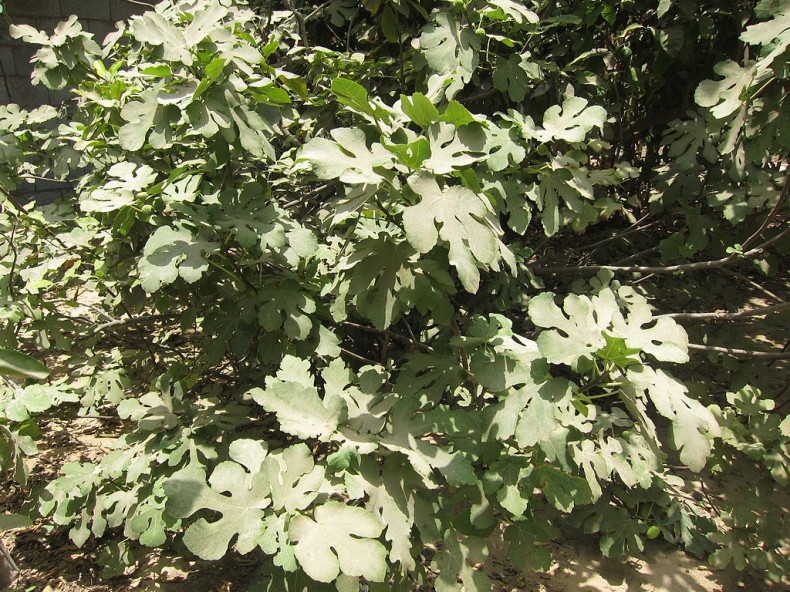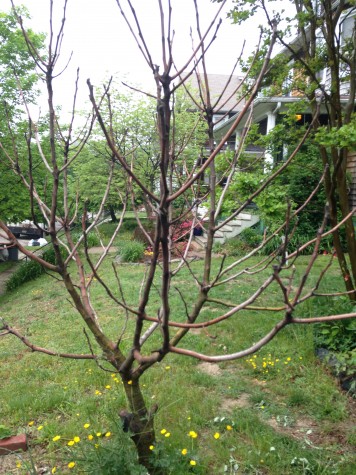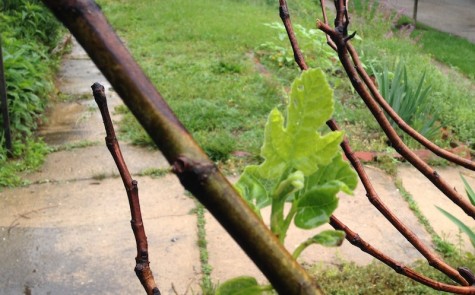
This winter in Baltimore we suffered. We steeled ourselves against record-breaking cold, and our heating bills were scandalous. There was so much snow that the children got tired of sledding. (It snowed on Tax Day, for Pete’s sake.) Months later, the potholes are punishing, and my fig tree is at death’s door.
As far as the fig is concerned, I’m in good company. My friends along the Eastern Seaboard have shared similar tales of woe. In Baltimore, the fig trees are bare and blackened. In Staten Island, my cousins have cut theirs down to the bottom hoping for new growth. And in Virginia one old friend is mourning the dearly departed tree that survived every winter since 1976.
You could say it’s a sad, mass die-off, but on the other hand—duh! I knew better. For decades I’ve admired my Uncle Sal’s Old-World horticultural savvy: fig trees shrouded in tarpaper and topped with buckets for the winter. He knows that fig trees aren’t supposed to grow in the mid-Atlantic, while I cavalierly figured the mid-Atlantic had warmed up. As he would say, “Stunata.”

When the USDA issued its first plant hardiness zone map in 1960, Baltimore was classified as Zone 6, and technically, that’s too cold to grow a Ficus carica, which needs at least a Zone 7 to thrive. But in my defense, I’ve been growing Zone 7 plants in Baltimore for 13 years with no problem. Every gardener worth her salt has known for years that the zones shifted, even if the USDA wasn’t updating its maps. (When the agency did finally update in 2012, Baltimore was reclassified as Zone 7b: old news by then.)
I’ll blame my lapse in judgment on climate change, which lulled me into a false sense of gardening security. If climate change were only a matter of warming, I would’ve managed all right. But there’s that pesky word: change. I had been thinking warm, and I should have been thinking unpredictable. If I want to keep growing things, especially food, I’ll need to figure out how to do it in our new climate, whatever that climate turns out to be.
In fact, we’ll all need to figure it out, especially the part about growing food. And when you think about climate change alongside its cousins Peak Oil, Peak Water, and the so-called Beepocalypse, we all really need to re-think what constitutes a feasible diet.
All things considered, a fig tree is a pretty good bet for the new era. The trees can tolerate seasonal drought and grow in kind of crappy soil. The fruit is very nutritious, providing an impressive amount of calcium and fiber. Considering the miniscule amount of resources required to grow a fig and transport it to my mouth, they’re a lot of bang for the buck.
Sadly, though, most of the foods I love rely on a plentiful supply of steady climate, oil, water, and pollinators—the things we’re running out of. California’s Central Valley has done a marvelous job of feeding me fruits and vegetables, but the cost is high: lots of water, lots of gasoline to ship the produce thousands of miles, and a lot of fertilizer made from petroleum. In April the National Climate Assessment warned us about the climate change challenges that farmers and food producers should get used to: not only the crippling droughts we’ve seen this year, but more pests, more fires, and more floods. It sounds like the kind of alarm that might be sounded by the Old Testament—but it’s the federal government, and those are some pretty expensive challenges.
At what point does it become unsustainable for businesses—and by “unsustainable for businesses,” I mean “not profitable”—to feed me in the manner in which I like to be fed? At what point does a Central Valley avocado traveling 3,000 miles to Maryland become a silly idea? In terms of feasible, a Baltimore fig trumps a California avocado any day—if only I can remember to wrap the darn tree in winter.

During the World Wars, people kept “victory gardens” to compensate for the short supply of food. During World War II, almost half of the produce being consumed in the U.S. was grown in these gardens. (In 1942, President Roosevelt instituted Daylight Savings Time to save energy, and according to lore, the shift allowed people returning home from work in the evenings to tend to their victory gardens in daylight.) I wonder if climate change will have a similar effect, with a food garden in every other yard—or if we’ll turn to economies of scale like community-supported agriculture, aka CSAs. Either way, our tastes will have to keep up. (My last CSA supplied me with so much pattypan squash, chard, and garlic scapes that I had to quit.)
I love figs, but I’d rather not have to give up avocados and almonds. As new climate realities change the rules of food-growing, I hope we can use the evidence that already exists to build more hardy and interesting food systems. There are great models in action already, a lot of proofs of concept about how to grow food in greater harmony with our natural resources. The holy grail is resilience, and we have to nail it. Fortunately, there’s good science out there to guide us, and adaptation is one of the things humans do well.
In my own little yard, it’s a waiting game to see if my fig tree springs back or gives up the ghost. I peeled back a bit of bark and found some green, so it might be wick. I’ve counted three leaf buds. If it’s still alive next winter, I’ll wrap it. In the meantime, maybe I’ll give rainbow chard another chance.
________
I’m a writer and editor at the Johns Hopkins Center for a Livable Future, where I focus on how our food systems affect the environment, our diets, public health, climate change, public policy—and vice versa. I also write as a freelancer about science, public health, parenting, people, and human rights. My true love is fiction writing. Natch, I’m working on a novel. Website. Twitter.
* * *
Photos: Wikimedia Commons (top); C. Grillo (center, bottom).
Two of our favorite fig trees (a friend’s in North Carolina and a sister’s in Geogia, died to the ground this year.
hi christine,
thanks for this blog piece. I found it through my friend Sarah Szanton on Facebook. I live in DC and have been wanting to plant a fig tree in my yard. I love figs and love the big loopy fig leaves. I grew up in california, but spent two years in NY when I was ages 3-5 and distinctly remember a fig tree in the back yard. Is that even possible?
Anyway, I still want to plant a fig and am willing to risk the heartbreak and disappointment. But would love any advice on it if you have any? Any suggestions on varieties (are there varieties?). location, light, etc.
yours in fig love,
Gawain
Hi Gawain,
It’s completely possible that you lived with a fig tree in NY! As for planting in DC, I live in Baltimore and did very well with Brown Turkey for years, until it just died. But if you go to this site, you’ll see varieties for different zones. DC/Baltimore is Zone 7b, but this winter it was much colder. I’d go with a Zone 5 or Zone 6 variety – there aren’t many, but there’s the Tennessee Mountain and the Chicago Hardy. http://www.tytyga.com/Fig-Trees-s/1852.htm
Wishing your fig tree a speedy recovery and hopefully you will be able to peel those beautiful purple cloaks in a couple of months. I had one in my yard in the mid-Atlantic and Augie my neighbor always warned us to cover it up in the winter months. Happy Nesting.
Thanks so much. As of mid-July, there’s a little bit of growth on one branch. Here’s a very recent NYTimes piece about the phenom of fig trees dying along the Eastern Seaboard. http://www.nytimes.com/2014/07/13/nyregion/a-fig-tree-dies-in-brooklyn-and-in-other-boroughs.html